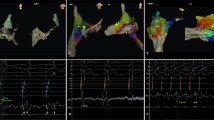Abstract
Catheter ablation via the femoral vein has been widely used in children. However, in certain conditions, an alternative vascular access is required for a successful ablation. Herein we reported that, accessory pathways (APs) and ectopic foci which reside right anterior and anterolateral to tricuspid valve orifice can be safely and effectively ablated with transjugular venous approach. Eleven procedures performed via the transjugular venous approach were reviewed retrospectively from the 355 electrophysiological procedures performed between March 2016 and November 2017. EnSite 3D electro-anatomic mapping and limited flouroscopy was used in all patients. The mean age of patients was 14.4 ± 2.9 years (12–18) and 6/11 (54.5%) were males. Seven of the patients had previous ablation procedures via the femoral vein approach and due to failure or recurrence the procedures had to be repeated. In these patients mean procedure time shortened from 196 ± 80 (105–280) to 111 ± 13 (96–125) min with the transjugular approach. 10/11 patients had APs, and one patient had focal atrial tachycardia. One of the APs was a Mahaim pathway. Ablation localisations were right anterior and right anterolateral in 8/11 and 3/11 patients respectively. The average fluoroscopy time was 3.38 ± 6.5 (0–15) min. All of the RF ablations via transjugular approach were successful (100%, 11/11). The mean follow-up period was 10.6 ± 1.1 (9–12) months. So far no recurrence has been observed. Right anterior and anterolateral regions are the most challenging areas in terms of catheter stabilization even when long sheaths are used during femoral route ablation. Ablation attempts in these regions have partial success, frequent recurrence, and high complication rates. This study revealed that transjugular approach seems as an effective alternative for those cases where transfemoral approach is unsuccessful for the ablation targets located in the right anterior and antero-lateral regions.


Similar content being viewed by others
References
Bhargava RA, Phatarpekar A, Lanjewar CP, Kerkar PG (2017) Modified transjugular approach for percutaneous atrial septal defect closure. Ann Pediatr Cardiol 10(2):197–199
Sullebarger JT, Sayad D, Gerber L, Ettedgui J, Jimmo-Waumans S, Alcebo PC (2004) Percutaneous closure of atrial septal defect via transjugular approach with the amplatzer septal occluder after unsuccessful attempt using the CardioSEAL device. Catheter Cardiovasc Interv 62(2):262–265
Wood M (2010) Ablation of free-wall accessory pathways. In: Stephen Huang SK, Miller JM (eds) Catheter ablation of cardiac arrhythmias, 3rd edn. Saunders Elsevier, Philadelphia, pp. 421–446
Friedman RA, Walsh EP, Silka MJ, Calkıns H, Stevenson WG, Rhodes LA, Deal BJ, Wolff GS, David AA, Demaso R, Hanisch D, Van Hare GF (2002) NASPE POSITION STATEMENT NASPE expert consensus conference: radiofrequency catheter ablation in children with and without congenital heart disease. Report of the writing committee. Pacing Clin Electrophysiol 25(6):1000–1017
Chen ML, Yang B, Ju WZ, Chen HW, Chen C, Hou XF, Zhang F, Cui JY, Zhang CH, Shan QJ, Zou JG, Sun JP, Xi YT, Cheng J, Cao KJ (2010) Right-sided free wall accessory pathway refractory to conventional catheter ablation: lessons from 3-dimensional electroanatomic mapping. J Cardiovasc Electrophysiol 21(12):1317–1324
Nguyen DT, Gupta R, Kay J, Fagan T, Lowery C, Collins KK, Sauer WH (2013) Percutaneous transhepatic access for catheter ablation of cardiac arrhythmias. EP Europace 15(4):494–500
Emmel M, Brockmeier K, Sreeram N (2004) Combined transhepatic and transjugular approach for radiofrequency ablation of an accessory pathway in a child with complex congenital heart disease. Z Kardiol 93(7):555–557
Jez J, Starek Z, Lehar F, Wolf J, Novak M (2015) Complex electrophysiology intervention in a patient with an inferior vena cava filter. Cor et Vasa 57:e341–e346
Kato H, Kubota S, Goto T, Inoue K, Oku N, Haba T, Yamamoto M (2017) Transseptal puncture and catheter ablation via the superior vena cava approach for persistent atrial fibrillation in a patient with polysplenia syndrome and interruption of the inferior vena cava: contact force–guided pulmonary vein isolation. EP Europace 19(7):1227–1232
Thanopoulos BD, Rigby ML (2005) Outcome of transcatheter closure of muscular ventricular septal defects with the Amplatzer ventricular septal defect occluder. Heart 91(4):513–516
Gülgün M, Karagöz T, Aykan HH, Ertuğrul İ (2015) Transjugular approach for radiofrequency ablation of permanent junctional reciprocal tachycardia in a newborn with bilateral femoral vein thrombosis. Turk Kardiyol Dern Ars 43(2):182–184
Bian C, Ma JI, Yao S, Xıngguangs LV, Wang JIE (2012) Transjugular approach for radiofrequency ablation of premature ventricular contractions originating from the superior tricuspid annulus. Pacing Clin Electrophysiol 35(12):e358–e360
DiLorenzo MP, Pass RH, Nappo L, Ceresnak SR (2012) Ablating the anteroseptal accessory pathway—ablation via the right internal jugular vein may improve safety and efficacy. J Interv Card Electrophysiol 35:293–299
Alcalde Ó, Vallés E, Benito B, Cabrera S, Jiménez J, Almor JM (2016) Changes in conduction properties of accessory pathways: from intermittent pre-excitation to rapid pre-excited ventricular response to atrial fibrillation. Rev Esp Cardiol 69:793–795
Author information
Authors and Affiliations
Contributions
YE contributed to the concept and design of the study, drafting and critical revision of the article. SÖ contributed to data collection, analysis, interpretation and final approval of the manuscript. GTS, HCK and AG contributed to data collection, concept and design of the study. SBC and BB were main practitioners of aforementioned method.
Corresponding author
Ethics declarations
Conflict of interest
The authors have no financial or other conflicts of interest related to this study.
Ethical Approval
This article does not contain any studies with human participants or animals performed by any of the authors.
Rights and permissions
About this article
Cite this article
Ergül, Y., Özgür, S., Şahin, G.T. et al. The Transjugular Approach: An Alternative Route to Improve Ablation Success in Right Anteriorly and Anterolaterally-Located Supraventricular Tachycardia Substrates in Children. Pediatr Cardiol 40, 477–482 (2019). https://doi.org/10.1007/s00246-018-1987-4
Received:
Accepted:
Published:
Issue Date:
DOI: https://doi.org/10.1007/s00246-018-1987-4




